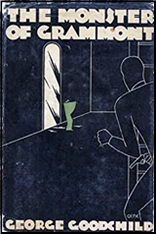Sat 5 Nov 2022
A Too Late for Halloween Mystery Review by Dan Stumpf: GEORGE GOODCHILD – The Monster of Grammont.
Posted by Steve under Reviews[5] Comments
GEORGE GOODCHILD – The Monster of Grammont. Hodder & Stoughton, UK, hardcover, 1927. Mystery League, US, hardcover, 1930.
I try to read at least one spooky book this time of year, and this year it was George Goodchild’s elusive novel, The Monster of Grammont.

I say “elusive†because I have seen this book at used book stores three times. The first two times I set it aside and someone else got it while I wasn’t looking. The third time I bought it with no difficulty, only to have it disappear for two weeks when I was halfway through it — turned out some idiot set a pile of junk overtop it while I was working in my basement. Terrible the help one gets these days. But I digress….
Monster starts off quite well, with two doughty Englishmen motoring through post-WWI France on Holiday, stopping at a chateau where one of them convalesced thanks to the hospitality of the owner, Count Fallieres, and finding the Count and his beautiful daughter (“She was just a child when I was here last…â€) beset by a nasty old ghost.
And when I say “nasty old ghost†I mean every inch of that phrase. No pallid whining blob of ectoplasm, this supernatural visitor is big, ugly, ill-tempered and quite capable of nailing doughty Englishmen to the floor when they venture too near, which our heroes do early on and often thereafter.
This sustains the first several chapters quite nicely, as everyone darts about the chateau in pursuit of the ghostly vandal until Fallieres get murdered for his trouble and Police Detective Fouchard is sent to investigate.
Only Fouchard doesn’t show up right away; an impostor takes his place and promptly vanishes when the real Fouchard shows up. Which sets up a whole different plot involving kidnappings, more impersonations, car chases, bombs, and still more plotting, till the Monster of Grammont gets rather displaced by all that mucking about.
Which is a shame, because the Monster was an entertaining brute, and the plot that replaces his antics seems tame and tepid by comparison. Worse yet, the story wraps up with a burst of niceness sure to disappoint readers who followed the earlier, nastier passages as avidly as I did.
There is a certain amount of charm in the attitudes and impressions of our post-Victorian heroes, but readers looking for an authentic chill had best put this down and seek elsewhere.
November 6th, 2022 at 12:13 am
Goodchild had a fairly good career as a thriller writer in the Edgar Wallace mode and a pretty long run. His name was often mentioned with Wallace, Horler, Captain A.O.Pollard, and Frank Froest, which was good company in that field.
I’m wondering if a shorter and somewhat less busy version of this might have appeared in THE THRILLER. My collection has huge gaps and I don’t know of a good bibliography of the magazine, but this sounds like the kind of thing that would fit well there.
It’s possible I either have an ebook of this I have yet to read or that issue of THRILLER because the title is familiar.
This is, unfortunately, pretty representative sounding of the plotting style of most of the books in this category which tended toward kitchen sink plots (the supernatural usually ended up something to do with a plot to smuggle cocaine, British thriller writers were obsessed with cocaine smuggling, even Allingham, Sayers, and John Rhode used it).
Many of these writers like E.S. Brooks (Berkeley Gray) and Allingham’s family came out of the Boys Own Paper and Sexton Blake school and wrote very fast in an almost stream of consciousness plotting style reminiscent of Nick Carter Nickl Library titles or Lester Dent Doc Savage stories that was pretty much what the whole Detection Club rules objected to.
Sensation was the game and they delivered but reading some of them you can pick up something by Sapper, and see he was, primitive as he may seem, writing at a far more sophisticated level than these.
In the heyday of the lending library patrons could be counted on to polish off two of these most weeks.
Goodchild still managed to have two books well received in Barzun and Taylor’s CATALOGUE OF CRIME and was author of the Inspector MacLean series and is generally remembered as one of the better practioners of the genre.
November 6th, 2022 at 2:13 pm
From Coodchild’s Wikipedia page:
” George Goodchild (1 December 1888 – 1969), also known as Alan Dare, Wallace Q. Reid, and Jesse Templeton, was a British writer of popular books, short stories, plays, and a writer and director of several movies.
“Over 200 Goodchild works were published during his lifetime and posthumously. His notable literary characters include Inspector McLean, spy catcher Q33 Trelawney, Nigel Rix, and Trooper O’Neill. Goodchild’s films include Colorado Jack (1921), Bucking the Barrier (1923), The Public Defender (1931), Condemned to Death (1932), Trooper O’Neill (1932), and No Escape (1936).”
https://en.wikipedia.org/wiki/George_Goodchild
A long list of books and story collections he wrote is included, with as you say, lots and lots of Inspector McLean stories. .
November 6th, 2022 at 7:03 pm
I have an unread copy of COLORADO JIM.
November 7th, 2022 at 1:45 am
I wonder how it might compare to some of John Creasey’s westerns.
November 8th, 2022 at 10:45 am
A Bill Deeck review of MCLEAN INVESTIGATES: https://mysteryfile.com/blog/?p=52322 — this one was right on time for Halloween.